In the Moment:
Michael Frye's Landscape Photography Blog
by Michael Frye | Oct 18, 2015 | Yosemite Photo Conditions
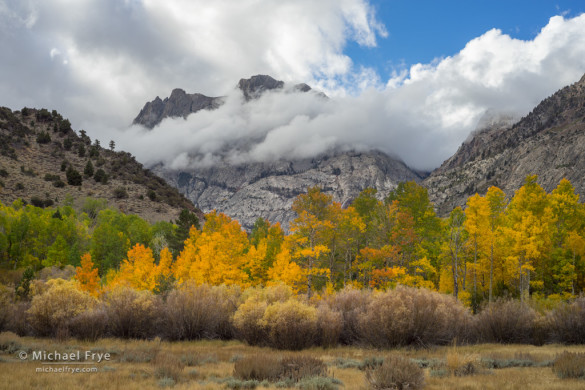
Peak and aspens during a clearing storm, June Lake Loop, Friday morning
The past week has been very warm, so there hasn’t been a big color change at the lower elevation aspen groves in the eastern Sierra during that time. But there’s definitely more color in those areas, and some great spots, although much of the June Lake Loop and Lee Vining Canyon are still green. Conway Summit, which is a little higher, has some very colorful groves, although it also has some bare trees, and green ones as well. Several spots in the greater Lee Vining area seem to have more oranges and reds than usual.
We also found some beautiful color in Bishop Creek Canyon. North Lake is past peak, though there was still some nice color along the shore. But lower down we found lots of colorful trees, especially along the road to South Lake.
(more…)
by Michael Frye | Sep 23, 2014 | Yosemite Photo Conditions
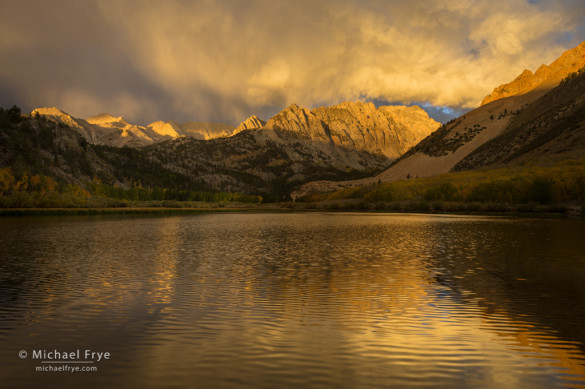
Stormy sunrise at North Lake, Bishop Creek Canyon, Sunday morning
After photographing lightning near Bishop on Saturday night (see my previous post), I thought there might be some interesting clouds still hanging around on Sunday morning, so I woke early and drove up to North Lake, near the upper end of Bishop Creek Canyon.
And there were clouds – almost too many. Another small rain squall was moving up from the south along the Sierra crest, approaching Bishop Creek Canyon just as the sun was due to rise. There were enough clouds to the east that I thought they might block the light. And I think some clouds lingering over the White Mountains did block the very first sunlight, but just after sunrise some clouds started to turn color overhead, and soon the peaks began to light up as well.
It evolved quickly into a dramatic scene. It was a little breezy, rippling the water surface, but there were still nice reflections at first. Then the wind increased, so I climbed up the ridge along the eastern shore of the lake to get a different perspective, one that didn’t depend as much on reflections.
(more…)
by Michael Frye | Dec 29, 2013 | Announcements
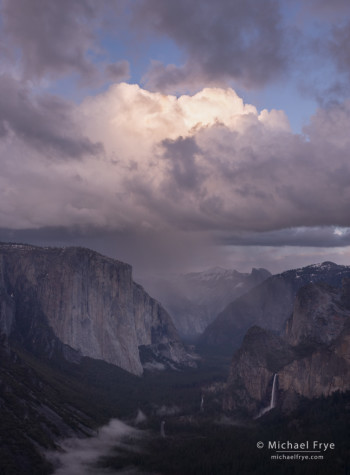
Rain squall over Yosemite Valley from near Old Inspiration Point, Yosemite
Photography encourages us to go to new places, and to be out during the most beautiful times of day when others are asleep or eating dinner. And sometimes – for me anyway – getting to those places can turn into a bit of an adventure.
Last April, on Easter Sunday, Claudia and climbed over 2,000 feet in elevation through rain squalls toward Yosemite’s Old Inspiration Point. We never actually made it there, but we found another good spot nearby, and had a great adventure, as described in my post A Harebrained Idea.
In August, the Rim Fire broke out west of Yosemite. The fire spread rapidly, expanding into Yosemite, and eventually becoming the third-largest fire recorded in California.
I knew this was a big event in the history of Yosemite, so I turned my attention to photographing the fire. During my first attempts I stayed close to the road, as I described in this post. But later Claudia and I made an epic bushwhack to a dome near the Tioga Road, where I captured a panorama of the fire at dusk, shown below.
In my original post about this day I actually didn’t go into much detail about the bushwhack. I’d visited this dome once before, many years ago, to photograph a shapely Jeffrey Pine visible from the road. I remembered it as being a tough hike – only about three miles, roundtrip, but with lots of brush, and clambering over rocks. Yet this seemed like the best place to get a view of the Rim Fire. We decided to go for it, hoping the trip wasn’t as bad as I remembered.
(more…)
by Michael Frye | Nov 26, 2013 | Composition, Photography Tips, Vision and Creativity
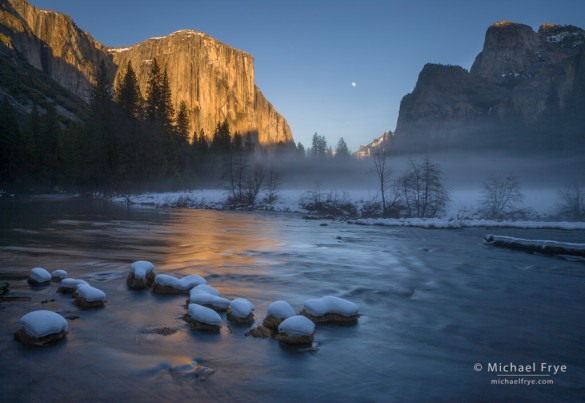
Moon rising between El Capitan and Cathedral Rocks from Valley View. What’s the least interesting part of this image?
The best compositions are simple; they present only the essentials, and leave out extraneous clutter. The most common mistake in photography – by far – is including too much in the frame. Anything that’s not adding to the photograph’s message is detracting from it.
To help simplify your compositions, ask yourself, before you press the shutter, “What’s the least interesting part of this photograph?” Try to identify the weakest area of your composition, and find a way to get rid of it. Then, once you’ve done that, ask the same question again: “Now, what’s the least interesting part of this image?” And get rid of that. And keep doing that until there’s nothing left that you could possibly cut out without losing something vital.
To give you some practice, look at the photograph above. What’s the least interesting part of that image? And if you got rid of that, what would be next – what’s the next least interesting part of the photograph?
I’ll give you a minute to think about it. When you’re ready, take a look at this next photograph, and answer the same question: what’s the least interesting part of this image?
(more…)
by Michael Frye | Oct 27, 2013 | Advanced Techniques, Photography Tips
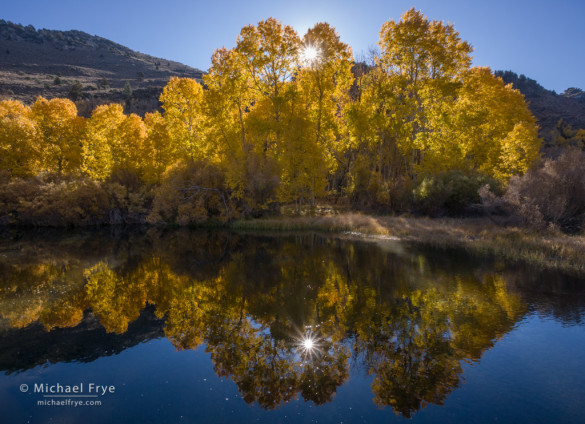
Aspens and morning sunlight, Inyo NF, CA, USA
I’ve always felt that the best photographs capture a mood or feeling. It’s easier to convey a mood when the weather gets stormy, but how do you capture a mood on a clear, sunny day? The answer, I think, is to go with it—to emphasize the sun, the blue sky, and the brightness of the day. Find the visual elements that say “beautiful, sunny day,” and highlight them.
One way of doing this is to include the sun in the frame. Nothing says “sunny and bright” like the sun itself. But putting the sun in your photograph brings challenges. First, you’re likely to get lens flare. This is not the end of the world—in fact, many photographs use lens flare to great effect—but sometimes the flare can be distracting. The other challenge is getting the exposure right.
(more…)













